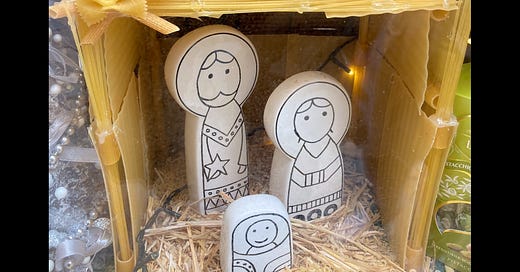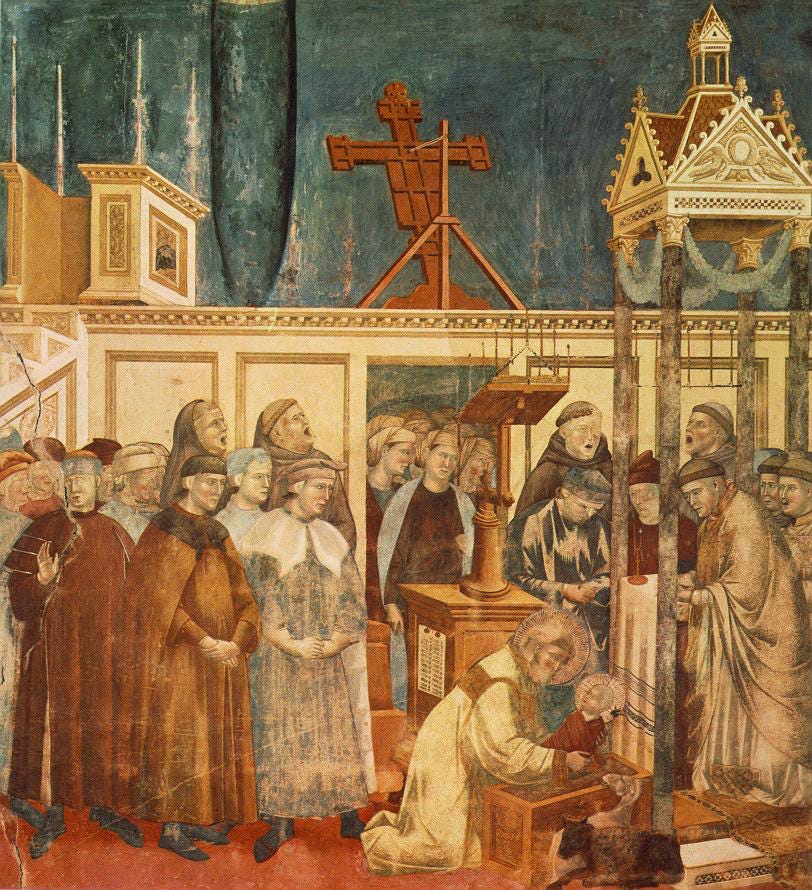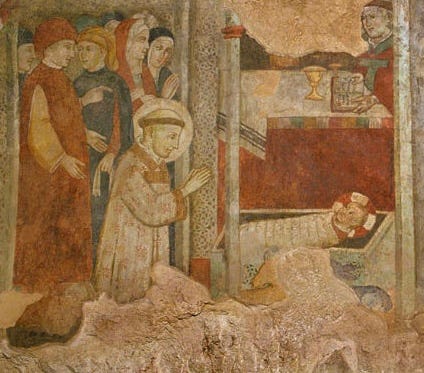Every December, the world becomes a patchwork quilt of tiny Bethlehems. On street corners, in shop windows, at craft fairs, or nestled in half lit oratories, the Holy Family refracted through a prism of techniques and materials, naive and artful. Terracotta, paper, yarn, pebbles, wood, glass, alabaster. No two are the same, yet each whispers the same story: a Child born into the ordinary, transforming it into something eternal.
I briefly pause while on my errands, captivated by the unassuming way these displays collapse time and space. Here, after all, is Bethlehem. Each Nativity scene is a reminder that the extraordinary is never far away. The thing about the season is that any moment can open onto the first Christmas.
The spatial repetition of nativities feels sacred, not stale. Seeing these scenes scattered everywhere, in their countless forms, is like encountering a ripple in reality. In some way, we’re all in on the same secret: that the story isn’t locked in the past. It’s alive, unfolding in real time, in every city, in every home where the faithful are gathered.
Because the Nativity scene isn’t just a quaint symbolic decoration we invented to adorn our holidays. Its roots lie much deeper, in the yearning of the faithful to somehow be present at the birth of the God-child. This desire began millennia ago, spurring pilgrimages to the Holy Land, where travelers would make their way to the grotto in Bethlehem — the very place tradition holds as the site of Christ’s birth.
For these pilgrims, simply visiting wasn’t enough. Standing in the Nativity grotto, they sought not just to see and touch but to enter into the moment itself, to annul the distance between their time and the time of sacred history. To achieve this, they developed meditative practices that made vivid and directed use of the imagination. Spiritual exercises like memoria locale (locative memory—where “memory” signifies more than mere remembrance, a tangible and vital witness locked within the holy sites, which the pilgrim must unlock for themselves).
Starting from an intensive awareness of presence at the place of the Savior’s entry into the world, in a dark, cramped, humble space that seemed to resist both the passage of time and the various cultures’ attempts at decoration, they felt the littleness of their existence cradled in divine timescales, and the physical imprint of the Christmas events still lingering in the stone. They could then try to “remember” — to perceive and reconstruct the scene in their minds, inscribing in empty space the relative positions of Mary, Joseph, and the Magi. They imagined themselves at the threshold of this scene, sharing the space with the Holy Family, until, for a fleeting instant, the boundaries of time blurred and they became “eyewitnesses” to sacred history, standing at the edge of eternity.
Men and women, lay and religious people wrote of their experiences back home, compiled narratives, and shared moments of spiritual insight, helping others achieve the sought-after feeling of involvement and existential heightening, teaching fellow pilgrims how to “see with the eyes of faith.”
When people visited the cave in groups, scattering to touch the walls and floor, kneeling in various attitudes of silence and prayer, it must not have been uncommon for each pilgrim, as they deliberately engaged their imagination to visualize the past, to lean on the physical presence of the others as placeholders for the personages of the Nativity. Each person would then become part of a living bridge between past and present — the elements of future “living nativities” already in place.
Saint Francis traveled to the Holy Land at the beginning of the 13th century. At the time, the Crusades were ongoing, and he sought to offer an alternative to violence. He met the Sultan, hoping to convert him to Christianity and end the bloodshed. Although the meeting was not successful in terms of religious conversion, it was significant in establishing a Franciscan presence in the Holy Land.
We have no straightforward, detailed account of Francis making it all the way to the cave in Bethlehem, but it is certain that his time in the region deeply influenced his spiritual life. His experiences, and those of the pilgrims he encountered on this journey, contributed to his understanding of Christ’s birth and humanity, and shaped the Saint’s devotion to the Nativity scene — culminating in the creation of the first living nativity. This was to materialize in Greccio, a small village close to the Italian city of Rieti, in 1223.
Saint Francis probably drew on pilgrims’ meditation techniques when he re-enacted the Nativity, displacing it on European soil. His goal wasn’t merely to retell the story in an engaging manner, akin to the dramatic theatricality of sacred representations, but rather to invite people into the same experience of vibrant, contemporaneous presence that pilgrims had sought for centuries. He re-created the scene so that those who couldn’t undertake the newly dangerous pilgrimage could still feel themselves there, immersed in the moment when heaven touched heart.
He staged the first life-sized, “living” Nativity in history in the woods — like the original holy site, some distance from the village — a liminal place midway between human settlements and the wilderness. He constructed a new crib with help from a craftsman, placed it in a cave with a live ox and donkey, and in the dead of night, he had the bells rung to summon the people. A Mass was celebrated, not by the Saint, who had never wished to be ordained a priest out of humility, but by the Bishop. Instead, Francis sang, explained the Gospel, and evoked the birth of the Christ child in words. Mary and Joseph were not included in the scene at this time.
“In that moving scene shines forth the simplicity of the Gospel: poverty is praised and humility presented to us in a positive way. Greccio has become like a new Bethlehem.” (Fonti Francescane 469)
By linking Mass and Nativity scene, Saint Francis underscored the Eucharistic significance of the pilgrims’ longing to unite timeliness and eternity. There is a place for this longing in the liturgy, and it is the Eucharist: like the Nativity scene, its more approachable symbol and prefiguration, something that can be simultaneously present in many sites and times while remaining undivided and eternally identical to itself. In fact, Mass was often celebrated in the Bethlehem grotto. The name “Bethlehem” means “house of bread”.
A famous fresco Giotto dedicated to the episode shows the Saint taking baby Jesus in his arms. It is not a local baby impersonating the God-child for the night. It is no doll, either (the crib had been left empty.) Instead, this work of art represents a vision experienced and testified by at least one person then present: John of Velita, knight. Giotto added somewhat incongruous architectural details to the scene, perhaps alluding to the buildings that would be constructed surrounding the site starting in 1228 and continuing into the last century. Giotto’s exquisite, impossibly lightweight architectures always exist suspended between the portrayal of real buildings with recognizable features, and ideal, rhetorical ones. Meanwhile, the real Sanctuary of Greccio, with its grotto chapel and church growing around the original core of the Saint’s retreat, preserves a Franciscan simplicity.
A humble follower of Giotto added this fresco to the lunette above the altar in the grotto:
Greccio was not, however, the first place to ever become “a new Bethlehem”. Rome’s Marian church of Santa Maria Maggiore (Sancta Maria ad Praesepe in the 7th century) gained the title of “Bethlehem of the West” when Pope Theodore I (642– 649) had the relic of the Holy Crib — the wooden fragments from the manger where Christ was laid — relocated there. The relic is still enshrined in a precious 19th century reliquary beneath the basilica’s altar (in November 2019, Pope Francis gifted a fragment to the Custody of the Holy Land.)
Following the Islamic conquest of Bethlehem, access had been increasingly restricted for Christian pilgrims. As a result, efforts had begun in Europe to construct local counterparts to the holy sites, according to the logic of “translation”. Like Jerusalem and Rome before it, Bethlehem became a portable repository of values — an affectively charged image of centered, meaningful reality that augmented people’s sense of place, and was readily surrogated by local landmarks both natural and artificial.
European churches began to imitate the layout of Bethlehem’s Basilica of the Nativity, and chapels mimicked the rough walls of the grotto. To the “vertical” dimension linking the present with the past, the trace left in the stone with its previous states in sacred history (the true destination of physical pilgrimage) there was added the “horizontal” dimension: a network of replicas — memorial nodes stretching across the surface of the world, linking the center to all its spatial iterations.
This proliferation was not simply a practical solution to the problem of commemoration and worship from afar; it also had theological implications. From one perspective, it was a “fall” back into myth, into “mere” religion — the “center of the world” mentality common to many traditions, which does not necessarily imply belief in a true historical event. This awareness kept the longing for the Holy Land, with its unique status in human history, sharply alive. From another perspective, the idea was affirmed that the Mystery of the Incarnation can be felt anywhere, wherever hearts are open to it. Not confined to one place or one time, Bethlehem is not just a town in Judea but a spiritual reality that can unfold in any corner of the world.
In 1289, to aid the “virtual” pilgrim approaching Bethlehem through Rome, Nicholas IV (the first Franciscan Pope) wished to have an artist create a lasting embodiment of the Nativity staged by Saint Francis less than a century earlier.
Although painted representations of the Nativity, intended as “snapshots” of visual narrative, date back to the earliest period of Christian worship (with the first Madonna and Child appearing in the Catacombs), Arnolfo di Cambio’s marble figures, standing as both objects of devotion and focal points for meditation, were the first sculptural group intended to draw the viewer into the scene, helping them imagine themselves as witnesses to the miraculous event.
It was the birth of the modern Nativity scene (Presepe), and the beginning of an artistic lineage that would eventually be incarnated in craftsmanship and even DIY.
Arnolfo di Cambio’s Nativity is currently housed in the chapel dedicated to Saint Jerome, to the left of the entrance to the Sistine Chapel. Only six marble figures survive from the original group: Saint Joseph, the three Magi, the ox and the donkey. The Madonna is attributable to a later sculptor: it is fully three-dimensional, worked in the round, whereas Arnolfo sculpted only the front, in a kind of extreme relief. Viewed from angles other than those for which they were designed, the figures appear distorted.
This origin story of the nativity scene reminds me that the little Bethlehems calling to me from shop windows and displays are not just symbols; they are echoes of a longing that has always sought to turn the ordinary into the sacred. They carry forward this ancient yearning to make the divine present, here and now. Each one a small attempt to dissolve the veil of time, to open a window into the eternal.
And yet, we must not forget the very real, sometimes painfully real, time and place that made this enchantment possible. The Basilica of the Nativity in Bethlehem is the only ancient Palestinian church to have escaped destruction again and again in the course of history, always eliciting respect and reverence from all faiths. But the region is once again war-torn, just as Saint Francis saw it eight centuries ago. Back in September/October, a Franciscan delegation from Tuscany was set on bringing a relic of the Saint’s blood to the Holy Land, to mark the 800th anniversary of his stigmata. Their flight was canceled when the conflict escalated. Their motto was From wounds, new life, their message to Palestinian Christians: “it is possible to inhabit wounds with hope and a desire for the future.” Christmas is a time for joy, but this year, it is also a time for wishing that joy may return to the Land that gave it to the rest of the world, keeping none for itself.








